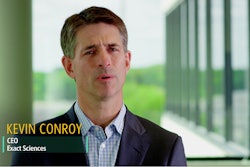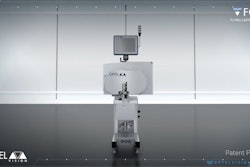Sunnybrook Health Sciences Center in Toronto, Canada, was good at discovering errors. For 12 years, the 42-bed, Level III regional neonatal intensive care unit (NICU) had been keeping track of errors that resulted in breast milk being fed to the wrong baby. To prevent errors rather than discover them after the fact, Sunnybrook turned to Neoteric Technology's (www.neoterictech.com) LacTrack SafeLx, a system that uses PDAs to ensure the right breast milk is fed to the right infant.
Prior to LacTrack, each step of the process-from milk collection, to preparation, to feeding-was verified visually. Then, as now, a mother expressed breast milk into a Mead Johnson (www.meadjohnson.com) 60-mL Grad-U-Feed container. Both the container and the cap are made of polypropylene and are free of latex, BPA, PVC, and phthalates. Milk was then poured into a 30- or 90-ml sterile milk storage container from Starplex Scientific Inc. (www.starplexscientific.com) and transferred to the feed prep area where technicians prepared the milk using additives, depending on the baby's nutritional needs.
Feeds were triple-checked and then delivered to the NICU where the nurse collected them from a communal refrigerator and delivered them to the baby's crib. Each feeding container had both a permanent thermal-transfer label and a removable version that the nurse peeled off and applied to the baby's crib card. The nurse then visually checked the baby's crib card against the feeding order and the feeding container.
"The nurse was her own double-check, but we knew that visual checks didn't work all the time, especially for feeds because they're very repetitive," says Dorothy Dougherty, Registered Nurse, Intl. Board Certified Lactation Consultant. "We do anywhere from 8,000 to 10,000 feeds a month. So when you have that many, at some point you look at your feed and see exactly what you need to see, not what's written there."
Because breast milk is considered a blood product, she says, if the wrong breast milk was fed to a baby, both mothers involved in the error had to undergo testing for the same diseases that pass through blood. Babies were not tested; however, if the mother whose breast milk was fed to the wrong baby refused testing, the baby who received the milk would have to undergo full blood testing after the incident and at six months of age to determine if any diseases had been transmitted. "It's emotional for these mothers, because they're already upset about their baby's condition," says Dougherty. "It's one more thing to wait and worry about."
Bar codes for infant feeds
Using LacTrack, every aspect of the milk collection, storage, and administration process is verified electronically and recorded in a central management system. Neoteric and Sunnybrook developed the software program, which sets high standards for feeding preparation.
Each of the 42 beds in the NICU has its own Zebra (www.zebra.com) QL 220 printer, and each nurse has a Motorola (www.motorola.com) MC 50 PDA with a built-in bar-code scanner. The system uses 2D bar codes with four unique identifiers: the baby's name, sex, date of birth, and medical record number. Using the hand-helds at the baby's bedside, the nurse scans his or her badge and the baby's identification and prints standard thermal labels for the milk collection containers. After the mother expresses milk into the containers, the technicians collect them and take them to the feed prep area.
Using the PDAs, the techs access the dietician or doctors' orders printed on 2 x 3-in. Z-Perform 1000D direct thermal paper labels from Zebra that tell them what feed to prepare. The techs scan themselves, the order, and the bottles of milk they need for each feed. If a mismatch occurs, the PDA sounds an alarm, alerting the tech to the error.
After verifying the orders, the technician prints the required number of feed labels on a permanent thermal-transfer label and attaches the label to the feeds that are prepared in the Grad-U-Feed disposable graduated nursers. The containers are delivered to the NICU and placed in the refrigerator. The nurse collects the feed for the baby and takes it to the bedside. She then scans her badge, the baby's crib card, and the feed. If all three scans match, she prints a label from the Zebra printer and places it in the baby's medical chart. If there is a mismatch, the critical alarm sounds, and she cannot proceed. "It's surprising the number of critical alarms triggered," notes Dougherty. "In one month we've had 40."
Information is downloaded wirelessly from the PDAs to a central database that Dougherty can check on a regular basis. Prior to implementing LacTrack, Dougherty did not know how many milk units were fed or how many errors went undiscovered. Now, the system provides a wealth of information about the process, from collecting to tracking, ordering, preparing, and feeding milk to the infants in the NICU.
Approximately 120 nurses and 30 doctors and dieticians are using LacTrack SafeLx. "The nurses are extremely happy with it," says Dougherty. "It's very easy to work with, and they wanted this technology because they didn't want to make errors."
Mothers no longer have to undergo testing for breast milk errors because staff is being alerted to errors before the feeding occurs. "It's difficult to put a financial cost on this," says Dougherty. "A lot of it you can't quantify, such as the emotional cost. We conducted follow-ups with parents involved in breast milk errors, and they all felt the same way. They didn't trust us much afterward. LacTrack has helped improve satisfaction with families because we have decreased the risk of a breast milk error occurring by 99.9 percent."
LacTrack SafeLx's success was recently recognized beyond the Toronto center as Neoteric and Sunnybrook won a 2008 MS-HUG (Microsoft Users Group) Healthcare Innovation Award in the category of delivery transformation. The award recognizes breakthrough contributions being made by healthcare organizations and individuals to drive efficiencies across the healthcare system.
-Kassandra Kania, Contributing Editor
Prior to LacTrack, each step of the process-from milk collection, to preparation, to feeding-was verified visually. Then, as now, a mother expressed breast milk into a Mead Johnson (www.meadjohnson.com) 60-mL Grad-U-Feed container. Both the container and the cap are made of polypropylene and are free of latex, BPA, PVC, and phthalates. Milk was then poured into a 30- or 90-ml sterile milk storage container from Starplex Scientific Inc. (www.starplexscientific.com) and transferred to the feed prep area where technicians prepared the milk using additives, depending on the baby's nutritional needs.
Feeds were triple-checked and then delivered to the NICU where the nurse collected them from a communal refrigerator and delivered them to the baby's crib. Each feeding container had both a permanent thermal-transfer label and a removable version that the nurse peeled off and applied to the baby's crib card. The nurse then visually checked the baby's crib card against the feeding order and the feeding container.
"The nurse was her own double-check, but we knew that visual checks didn't work all the time, especially for feeds because they're very repetitive," says Dorothy Dougherty, Registered Nurse, Intl. Board Certified Lactation Consultant. "We do anywhere from 8,000 to 10,000 feeds a month. So when you have that many, at some point you look at your feed and see exactly what you need to see, not what's written there."
Because breast milk is considered a blood product, she says, if the wrong breast milk was fed to a baby, both mothers involved in the error had to undergo testing for the same diseases that pass through blood. Babies were not tested; however, if the mother whose breast milk was fed to the wrong baby refused testing, the baby who received the milk would have to undergo full blood testing after the incident and at six months of age to determine if any diseases had been transmitted. "It's emotional for these mothers, because they're already upset about their baby's condition," says Dougherty. "It's one more thing to wait and worry about."
Bar codes for infant feeds
Using LacTrack, every aspect of the milk collection, storage, and administration process is verified electronically and recorded in a central management system. Neoteric and Sunnybrook developed the software program, which sets high standards for feeding preparation.
Each of the 42 beds in the NICU has its own Zebra (www.zebra.com) QL 220 printer, and each nurse has a Motorola (www.motorola.com) MC 50 PDA with a built-in bar-code scanner. The system uses 2D bar codes with four unique identifiers: the baby's name, sex, date of birth, and medical record number. Using the hand-helds at the baby's bedside, the nurse scans his or her badge and the baby's identification and prints standard thermal labels for the milk collection containers. After the mother expresses milk into the containers, the technicians collect them and take them to the feed prep area.
Using the PDAs, the techs access the dietician or doctors' orders printed on 2 x 3-in. Z-Perform 1000D direct thermal paper labels from Zebra that tell them what feed to prepare. The techs scan themselves, the order, and the bottles of milk they need for each feed. If a mismatch occurs, the PDA sounds an alarm, alerting the tech to the error.
After verifying the orders, the technician prints the required number of feed labels on a permanent thermal-transfer label and attaches the label to the feeds that are prepared in the Grad-U-Feed disposable graduated nursers. The containers are delivered to the NICU and placed in the refrigerator. The nurse collects the feed for the baby and takes it to the bedside. She then scans her badge, the baby's crib card, and the feed. If all three scans match, she prints a label from the Zebra printer and places it in the baby's medical chart. If there is a mismatch, the critical alarm sounds, and she cannot proceed. "It's surprising the number of critical alarms triggered," notes Dougherty. "In one month we've had 40."
Information is downloaded wirelessly from the PDAs to a central database that Dougherty can check on a regular basis. Prior to implementing LacTrack, Dougherty did not know how many milk units were fed or how many errors went undiscovered. Now, the system provides a wealth of information about the process, from collecting to tracking, ordering, preparing, and feeding milk to the infants in the NICU.
Approximately 120 nurses and 30 doctors and dieticians are using LacTrack SafeLx. "The nurses are extremely happy with it," says Dougherty. "It's very easy to work with, and they wanted this technology because they didn't want to make errors."
Mothers no longer have to undergo testing for breast milk errors because staff is being alerted to errors before the feeding occurs. "It's difficult to put a financial cost on this," says Dougherty. "A lot of it you can't quantify, such as the emotional cost. We conducted follow-ups with parents involved in breast milk errors, and they all felt the same way. They didn't trust us much afterward. LacTrack has helped improve satisfaction with families because we have decreased the risk of a breast milk error occurring by 99.9 percent."
LacTrack SafeLx's success was recently recognized beyond the Toronto center as Neoteric and Sunnybrook won a 2008 MS-HUG (Microsoft Users Group) Healthcare Innovation Award in the category of delivery transformation. The award recognizes breakthrough contributions being made by healthcare organizations and individuals to drive efficiencies across the healthcare system.
-Kassandra Kania, Contributing Editor





















